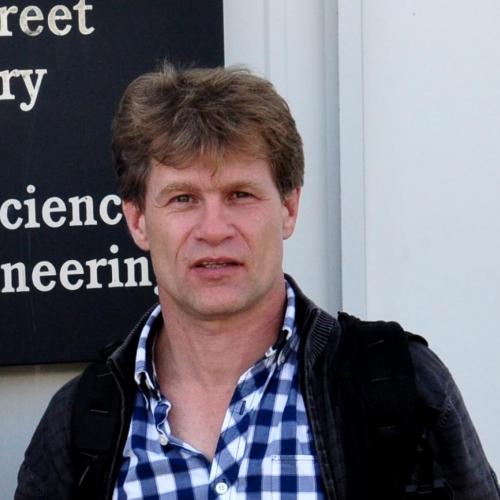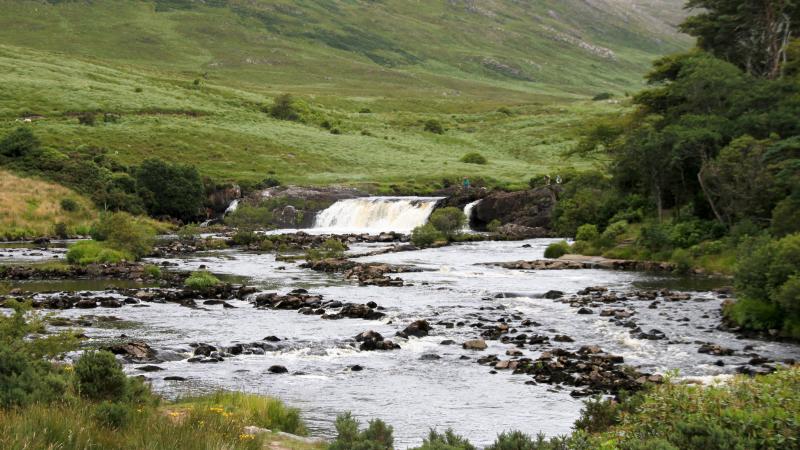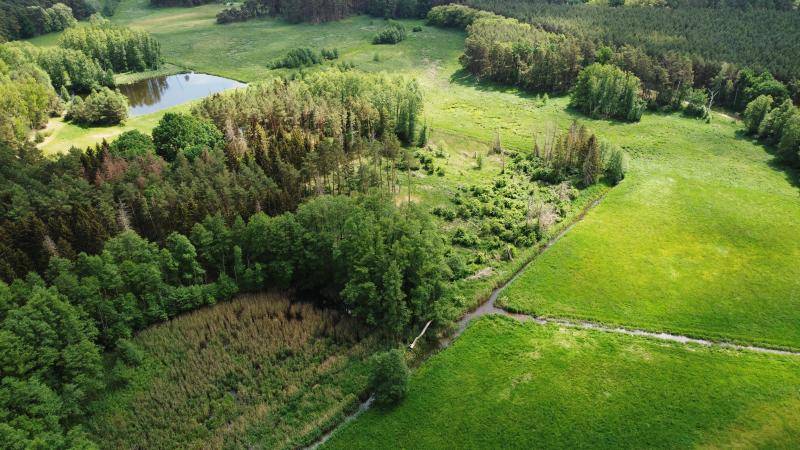
The view of the RIVER LAB with a model patch of riparian vegetation in 2019. | Photo: IGB
Alexander Sukhodolov returned from the Tagliamento just a few weeks ago. “In summer, we have stable conditions at our field site for three whole months,” reported the Research Group Leader at IGB. This means that he and his team are able to conduct dozens of experiments under virtually stable conditions, varying parameters of interest – the ideal way to test theoretical frameworks in practice.
Habitat for unique flora and fauna
The Tagliamento sources in the Southern Alps in north-east Italy and flows into the Adriatic Sea some 170 kilometres away. The largely unregulated river is considered the most important last remaining intact river in the Alps. This is due to a number of characteristics: the river system makes up an enormous corridor, covering more than 150 square kilometres, that connects land and sea and two important habitats: the Alps and the Mediterranean. This corridor provides a “dynamic mosaic of aquatic-terrestrial habitats,” as once described by former IGB Director Klement Tockner, who started researching the Tagliamento even before the turn of the millennium, and his co-authors: Deeper and shallower river branches are connected over an extensive floodplains separated by hundreds of islands and moveable gravel bars because of mobility of the composing sediments containing different types of rock – metamorphic, limestone and volcanic. The Tagliamento provides a habitat for unique flora and fauna, and is the ideal place to study how natural processes occur in a largely free-flowing river.
How does a river flow?
The idea behind the River Lab is to better understand how a natural fluvial ecosystem works and how then we can use this knowledge to develop effective river protection and management programmes. According to Alexander Sukhodolov, the River Lab serves as a platform for combining traditional fieldwork and laboratory research: using the theoretical models, the researchers integrate physical laws that affect the fluvial system. The River Lab is used to verify whether those theories fit. For this purpose, the scientists use a shallow tributary of the Tagliamento, which is separated from the main river by a gravel bar in summer and is fed solely by groundwater. “Stable hydraulic conditions prevail here during the summer months,” the researcher remarked.
Experiments and measurements are carried out in a shallow in-stream flume measuring 40 metres long, 5 metres wide and 35 cm deep. This flume can be altered as required, e.g. to conduct specific experiments. For example, Sukhodolov and his team create in the flume a patch of aquatic vegetation made of silicone models of S. sagittifolia plants. This vegetation patch can be used to study the interactions of their real-life prototypes with turbulent flows at different flow rates.
Flow structure in rivers also has an impact on fish
Another project carried out in recent years explores the flow behaviour of two confluent rivers. “In the channel, we constructed a model of river confluences. We are able to vary different parameters, such as the volume of the incoming water or the junction angle of the confluence ” reported Alexander Sukhodolov. After all, the flow behaviour that occurs when two rivers merge into one is sometimes different in nature to what we might expect from the simple laboratory experiments because sometimes rivers mix over a very short distances and sometimes it takes quite long at the same confluence, like where the Danube meets the Sava in Belgrade, Serbia. “A mixing interface forms between the two rivers, along which the mixing can be very complex and governed by different factors” stated the researcher. According to the findings of the IGB team, the length or time for which this interface remains stable depends to a great extent on the depth of the river in the area downstream of the confluence and to what extent flow velocity differs. The riverbed roughness also plays a key role: it can inhibit the lateral turbulence, preventing merging flows from mixing for many kilometres downstream.
“This phenomenon is ecologically important. Salmon and sturgeon, for example, use their ability to smell mineral composition of waters and to use that for returning to the place where they hatched upstream, which is then in turn used as a spawning ground,” explained Alexander Sukhodolov. Each river has its own specific mineral composition; if two rivers do not mix over a long distance, migratory fish are better able to navigate because they can swim through “their native” waters.
The future of the Tagliamento
Findings such as these help to protect river biodiversity in a world marked by climate change. So far, according to Alexander Sukhodolov, global warming has not had a noticeable effect on the Tagliamento: “Rivers in other regions of Italy are now more prone to flooding than in the past, but this is not the case for the Tagliamento river system.” However, the growing agricultural use of land in the river catchment area is problematic.
History has also left a burden on the river: unexploded bombs from the World War II remain in some parts of the river floodplain and gravel bars. Meanwhile, however, things are moving: the local community is increasingly concerned about the problems facing the Tagliamento, leading to the recent foundation of the Legambiente association. IGB also participates in this organisation’s activities. In this context, for example, the problem of plastic polluting the river corridor is being investigated.
Text: Wiebke Peters
The RIVER LAB with the participants of the 4th graduate school of the ITN RIBES project in 2022. | Photo: IGB
IGB postdoc Oleksandra Shumilova at a model patch of riparian vegetation used in the RIVER LAB experiments in 2019. | Photo: IGB

View of the RIVER LAB with a confluence model in 2015 | Photo: IGB
Confluence model during the RIVER LAB experiments in 2015. | Photo: IGB







